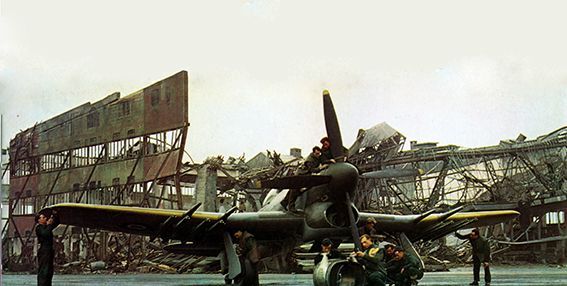
Wing Commander Baldwin's Typhoon of the 146th Wing RAF operating from Antwerp. The aircraft was later destroyed by a V2 impact.
RAF Base Antwerp B70
The Germans did not give up easily. To make things difficult for the Allies, the airport was destroyed. The large hangar was blown up and the Stampe and Vertongen factories were completely destroyed. Nevertheless, the airport remained operational and the British were able to take up residence with their Typhoons on base “B70”. Later the airport was used for storing surplus army material.
The Germans spent five years at the airport.
What was initially an airfield was provided by them with a paved runway, which, despite the 'Deutsche Gründlichkeit', is badly planted in terms of direction and is perpendicular to the prevailing wind direction. The reason for this is the visual approach, with Fort III serving as a landmark.
The entire airport building was camouflaged. The photos clearly show false facades that were applied to the building. But the large hangar was also painted in such a way that it could pass for an apartment building.
Just before their retreat, they disabled the installations by blowing up the large hangar - the rubble was later cleared away by arrested collaborators - and the factories of Stampe and Vertongen.
However, the runway remained undamaged.
The Royal Air Force (RAF) took up residence at Antwerp "B70" base on September 17, 1944 (barely 2 weeks after the liberation of Antwerp). From here they undertook attacks on German targets in The Netherlands and Germany.
The RAF continued to make active use of the "B70" until February 1945. After that it was regularly used to receive high-ranking visitors in a relatively calm environment, including Generals Omar Bradley, Mark Clark and George Patton.
In April came the ultimate humiliation: "B70" was closed and the runway used for the storage of hundreds of trucks, guns and other equipment.
And the liberation of Europe continued...
Photo captions (top-left to bottom-right)
- The large hangar was blown up by the Germans, but the airport remained operational. The building was later restored to its original state. (Coll. Jean Dillen)
- There were undoubtedly artists among the occupying soldiers. In some rooms the emblems of based units and visitors of Fliegerhorst Antwerp were painted on the wall. There is even an English logo of a Spitfire that crashed on Antwerp. (Coll. Jean Dillen)
- During their stay at the airport, the Germans had camouflaged the buildings as houses, in order to make attacks from the air more difficult. The 'fake' facades and gabled roofs are clearly visible on the right, while facing bricks and windows were painted on the side of the large hangar. (Coll. Jean Dillen)
- During renovation work in 2005, part of the brick wall painted by the Germans was exposed under a commemorative plaque. (Coll. Carl Gootzen)
- High visit on 13/10/1944: the British '2nd Tactical Air Force' holds a meeting at "B70". King George IV meets Marshal 'Monty' Montgomery here at Antwerp Airport. The visit was cut short when the first V2 hit Antwerp. (Col. Jean Dillen)






